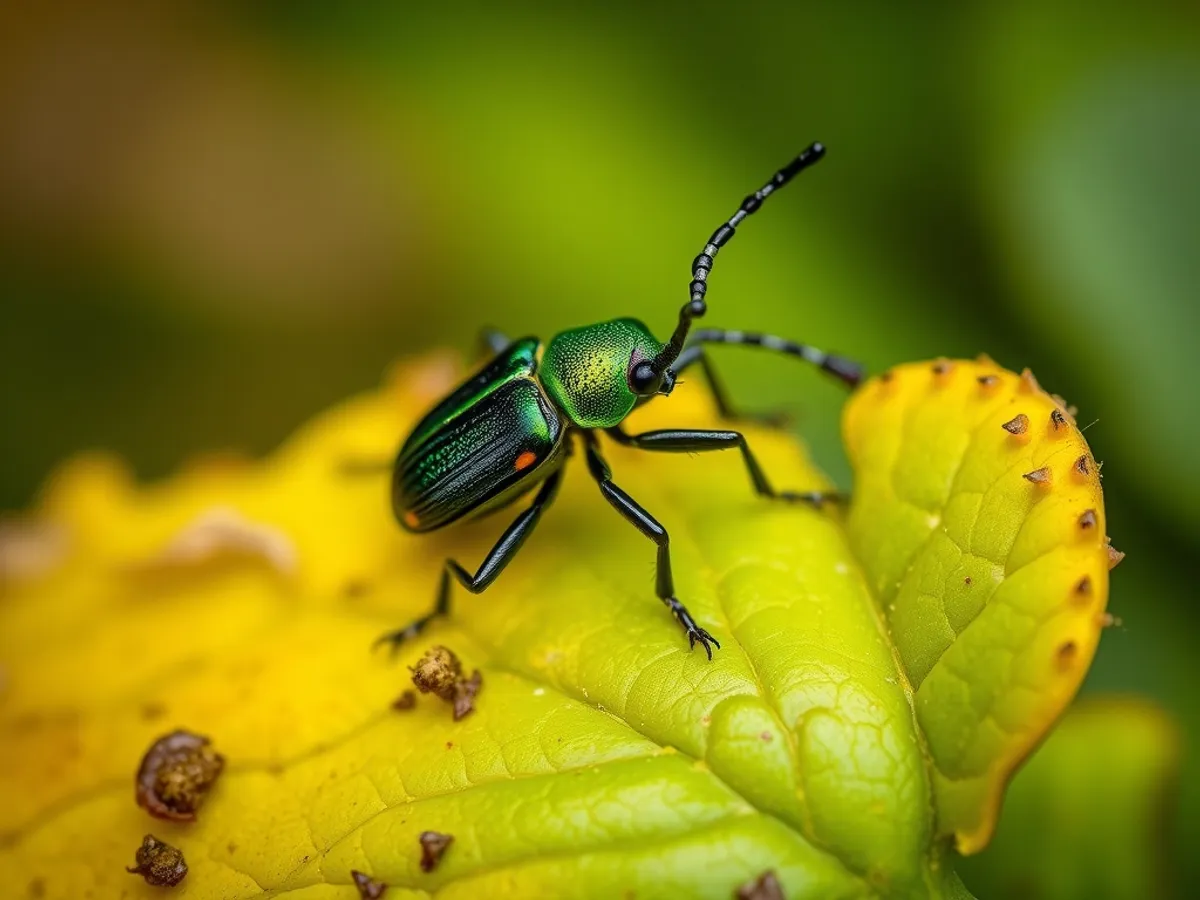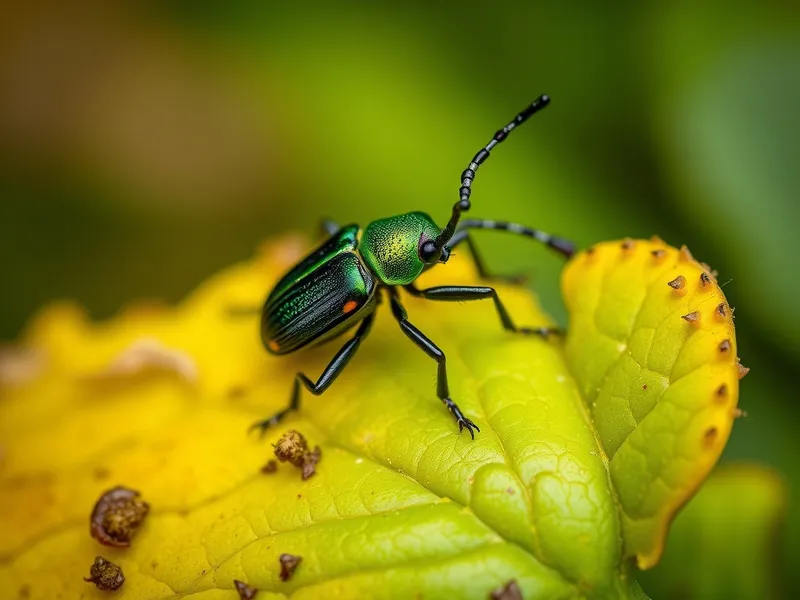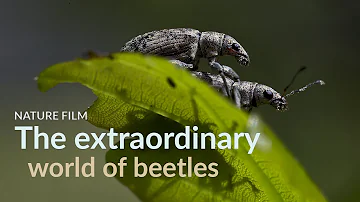
Cucumber Beetle
Diabrotica undecimpunctata

Meet the Cucumber Beetle
The cucumber beetle is a small, brightly colored insect commonly found in agricultural fields, especially those growing cucurbits like cucumbers, melons, and squash. Recognized by its yellow-green body and distinctive black spots or stripes, this beetle is notorious for its role as a pest, feeding on leaves, stems, flowers, and fruits. Both larvae and adults can cause significant crop damage, and the beetle is also a vector for plant diseases such as bacterial wilt and mosaic virus. Their adaptability and high reproductive rate make them challenging to control in many regions.
Classification
Invertebrate
Habitat
Fields, gardens, and agricultural areas
Diet
Herbivore
Lifespan
1-2 months
Conservation
Least Concern
Weight
0.01-0.03 grams
📖Fascinating Facts
Pest Status
Cucumber beetles are major agricultural pests, causing both direct damage by feeding and indirect damage by spreading plant diseases.
Host Plant Preference
They primarily target cucurbit crops such as cucumbers, squash, melons, and pumpkins, but can also feed on other vegetables and ornamentals.
Life Cycle
The beetle undergoes complete metamorphosis with egg, larva, pupa, and adult stages, and can have multiple generations per year in warm climates.
📋Detailed Description
The cucumber beetle, Diabrotica undecimpunctata, is a small chrysomelid beetle measuring approximately 5–7 mm in length. Its body is elongated and oval, with a distinctive yellow-green coloration and eleven conspicuous black spots on each elytron (wing cover), giving rise to its species name 'undecimpunctata' (Latin for 'eleven-spotted'). The head is equipped with well-developed, filiform antennae and strong mandibles adapted for chewing plant material. Adult beetles are highly mobile, capable of both walking and flying, and are most active during warm, sunny periods. Larvae are slender, white, and worm-like, specialized for subterranean life where they feed on plant roots. The beetle's lifecycle includes complete metamorphosis: egg, larva, pupa, and adult. Adults are solitary but may aggregate in large numbers on host plants, especially during peak feeding and mating periods. Diabrotica undecimpunctata is notorious for its role as an agricultural pest, not only due to direct feeding damage but also as a vector for pathogens such as Erwinia tracheiphila (bacterial wilt) and cucumber mosaic virus. Its ability to exploit a wide range of host plants, rapid reproductive rate, and resistance to some pesticides contribute to its pest status.
💡 Did you know?
Cucumber beetles are not just crop pests; they can also transmit deadly plant diseases, making them a double threat to agricultural production.
🔬Research & Sources
Wikipedia Summary
Cucumber beetle is a common name given to members of two genera of beetles, Diabrotica and Acalymma, both in the family Chrysomelidae. The adults can be found on cucurbits such as cucumbers and a variety of other plants. Many are notorious pests of agricultural crops. The larvae of several cucumber beetles are known as corn rootworms.
Last Modified: 3/31/2025
🎭Behavior & Social Structure
Cucumber beetles exhibit primarily crepuscular and diurnal activity, with peak feeding and mating occurring during daylight hours. Adults feed voraciously on the foliage, flowers, and fruits of cucurbit plants, often causing characteristic holes and scarring. They are generalist feeders but show a marked preference for cucurbits, attracted by plant volatiles. When disturbed, adults may drop to the ground and feign death (thanatosis) or quickly fly away. Social interactions are minimal; aggregation occurs mainly due to resource availability rather than cooperative behavior. Larvae remain below ground, feeding on roots and stems, which can stunt plant growth or cause seedling mortality. Both life stages are capable of dispersal: adults by flight, larvae by burrowing. Feeding behavior is opportunistic, and adults may switch host plants if preferred resources are depleted.
👶Reproduction & Life Cycle
Reproduction in Diabrotica undecimpunctata is seasonal, with mating typically occurring in late spring to early summer, synchronized with the emergence of host plants. Females lay clusters of 200–1,200 small, yellowish eggs in moist soil at the base of host plants. Incubation lasts 5–9 days, depending on temperature and humidity. Larvae undergo three instars over 2–4 weeks, feeding on roots before pupating in the soil. The pupal stage lasts 7–10 days, after which adults emerge. There are generally one to three generations per year, with voltinism (number of generations) increasing in warmer climates. No parental care is provided; survival of offspring depends on environmental conditions and availability of suitable host plants.
🛡️Adaptations & Survival
Cucumber beetles possess several adaptations for survival and pest success. Their cryptic coloration provides camouflage among foliage, while the hard elytra protect against predators and desiccation. Adults sequester cucurbitacins—bitter compounds from host plants—making them distasteful to many predators. Their rapid reproductive cycle and high fecundity enable quick population growth. Behavioral adaptations include thanatosis and rapid flight responses to disturbance. Larvae are adapted for subterranean life, with specialized mouthparts for root feeding and the ability to burrow through soil. The beetle's ability to vector plant pathogens is facilitated by its feeding behavior and mouthpart structure, which can introduce bacteria and viruses into plant tissues.
📚Research Sources
🎨Cultural Significance
Cucumber beetles have limited positive cultural significance but are well-known in agricultural communities as emblematic pests. Their presence in folklore or symbolism is minimal, though they are sometimes referenced in gardening literature as a cautionary example of pest resilience. The economic impact of cucumber beetles has influenced agricultural practices and research into pest management. In some regions, their arrival marks the need for seasonal pest control measures among farmers and gardeners.
🔬Recent Research & Discoveries
Recent research has focused on the beetle's role as a vector for bacterial wilt and mosaic virus, with studies examining the molecular interactions between beetle, pathogen, and host plant. Genomic studies have identified genes associated with pesticide resistance, informing the development of new management strategies. Behavioral ecology research has explored host plant selection mechanisms, revealing the importance of plant volatiles and cucurbitacin content in beetle attraction. Ongoing studies are investigating biological control agents, such as parasitoid wasps and entomopathogenic fungi, as alternatives to chemical pesticides. Advances in integrated pest management (IPM) are being tested in field trials to reduce reliance on broad-spectrum insecticides.
🎥Wildlife Videos

Africa's Dung Beetles: The Ultimate Recyclers | Wildlife Icons Ep103
There are more species of beetle in the world than any other animal, and few play a role as important as the humble dung beetle.
Love Nature

Wildlife - Just Insects | Free Documentary Nature
Wildlife - Episode 5: Just Insects | Wildlife Documentary Watch 'Wildlife - Episode 6' here: https://youtu.be/nfpzQyi9UFU Earth is ...
Free Documentary - Nature

The extraordinary world of beetles
Beetles are one of the most numerous orders of insects. They come in all shapes and sizes. They inhabit a variety of habitats.
Forest Film Studio

The Tiny World Of Insects | BBC Earth
Just because these insects are small doesn't mean they're not mighty. Watch as these tiny creatures return form the dead and ...
BBC Earth

Facts About Beetles - Secret Nature | Beetle Documentary | Natural History Channel
Beetles have been around for over 250 million years. Earth is covered with these amazing insects and now you can learn about ...
Banijay Wild

Tiny Titans - The Fascinating World of Insects | Free Documentary Nature
Tiny Titans - The Fascinating World of Insects | Wildlife Documentary Watch 'Wildlife - Just Insects' here: ...
Free Documentary - Nature
🌍Habitat Information
The Cucumber Beetle typically inhabits Fields, gardens, and agricultural areas environments. Cucumber Beetles have adapted to their environments with specialized features and behaviors.
Primary Habitat:
Fields, gardens, and agricultural areas
More detailed habitat information will be available soon.
🛡️Conservation Status
The Cucumber Beetle is currently classified as Least Concern. Conservation efforts are crucial for preserving this species for future generations.
Common Threats:
- 🏠Habitat loss and fragmentation
- 🌡️Climate change impacts
- 🎯Hunting and poaching
- 🏭Human-wildlife conflict
⚠️Threats & Conservation Challenges
While Diabrotica undecimpunctata is not currently threatened and is classified as Least Concern, it faces natural predation from birds, spiders, and predatory insects. Parasitic wasps and entomopathogenic nematodes also regulate populations. However, widespread pesticide use in agriculture has led to the development of resistance in some populations, complicating management. Climate change may expand the beetle's range and increase voltinism, exacerbating its pest status. Crop rotation, biological control, and integrated pest management (IPM) are increasingly important for sustainable control. Human impact is primarily negative, as the beetle is a major agricultural pest with significant economic consequences for cucurbit and corn production.
🔬Scientific Classification
Scientific Name
Diabrotica undecimpunctata
Classification Hierarchy
🔍 About Taxonomic Classification
Taxonomic classification is a hierarchical system used by scientists to classify and organize living organisms based on shared characteristics and evolutionary relationships.
The system moves from broad categories (Kingdom) to increasingly specific ones, with each animal's scientific name typically consisting of its Genus and species.
📝Community Notes
Share your observations and insights about the Cucumber Beetle with our community of wildlife enthusiasts.
Join Our Community
Sign in to share your observations and connect with fellow wildlife enthusiasts.
Sign In to ContributeNo community notes yet
Be the first to share your observations about the Cucumber Beetle!
Explore Cucumber Beetle
Select a tab above to learn more about this amazing animal.
📸Photo Gallery
No photos available for this animal yet.
🌟Discover More Wildlife
Continue your journey of discovery with more fascinating animals from our database
